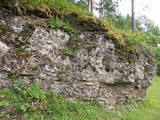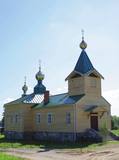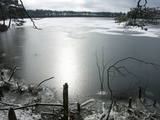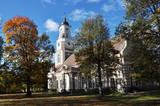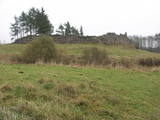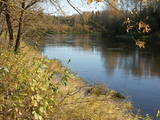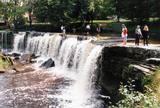| Nr | Nosaukums | Apraksts |
|---|---|---|
|
"Smilškalnu" dārzos audzē upenes, kazenes, avenes, smiltsērkšķus u.c., no kuriem ražo mājas vīnu. Degustācijas rīko savā vīna darītavā, bet tās iespējams noorganizēt arī Padures Muižā. |
||
|
Upes tecējuma ziņā – straujš un vietām krāčains Gaujas posms starp Vidagu un Vecpalsas ieteku, kura (un kura pieteku) krastos vietām sastopami dolomīta atsegumi, no kuriem lielākie ir Randatu klintis. Liegums veidots g.k. dažādu mežu, pļavu un ar atsegumiem saistītu biotopu aizsardzībai. Arī no ainaviskā un ūdenstūrisma viedokļa – interesants Gaujas vidusteces posms. Izveidoti labiekārtojuma elementi Randatu klinšu apskatei u.c. Teritorija ietilpst Ziemeļgaujas aizsargājamo ainavu apvidū (sk. sadaļu "Aizsargājamo ainavu apvidi").
|
||
|
Tiskādu pareizticīgo baznīca ir vietējās nozīmes arhitektūras piemineklis,
celta 1829. – 1878. gadā, atjaunota 2008. gadā. Baznīcā izvietotas senas ikonas,
garīgo grāmatu bibliotēka. Pašlaik tajā notiek dievkalpojumi.
|
||
|
Lubāna ezers, Lubāna mitraine. Lubāns – platības ziņā lielākais
ezers (80,7 km2) Latvijā, vislielākais iedambētais ezers Eiropā, un ap
to esošais Lubāna mitrājs bioloģiskās daudzveidības ziņā ir unikāla
vieta ne tikai Latvijā, bet arī starptautiskā mērogā – dabas liegums,
iekļauts Eiropas Savienības aizsargājamo teritoriju tīklā NATURA 2000
un atbilstoši Ramsāres konvencijas kritērijiem – starptautiskas nozīmes
mitrājs. Lubāna mitrājs, ko vietējie iedzīvotāji jau izsenis dēvē par
klāniem, ir zemie un augstie purvi, slapjās pļavas, mitrie meži.
Rudeņos un pavasaros ūdenskrātuvēs apmetas tūkstošiem migrējošu
ūdensputnu, kurus ērti novērot no putnu novērošanas torņiem vai ūdenstūrisma attīstības centra terases.
|
||
|
Relatīvi grūti pieejama un cilvēka mazskarta teritorija kūdrā izstrādātajā Cenas tīreļa ziemeļaustrumu daļā, kur saglabājušies augstā purva biotopi ar purva ezeriem, kas kopumā veido nozīmīgu vietu ligzdojošām un migrējošām zosveidīgo, tārtiņveidīgo u.c. putnu sugām. Teritorija nav piemērota (un nav vēlams) tūrisma aktivitātēm.
|
||
|
Baznīca atrodas pašā pilsētas centrā. Tā celta laikā no 1781. līdz 1788. gadam un tās celšanas iniciators bija Alūksnes muižas īpašnieks Oto Hermanis fon Fītinghofs, tās arhitekts – Kristofs Hāberlands. Noskatītā vieta, netālu no ezera, bijusi purvaina. Tādēļ uzbērts uzkalniņš un baznīcas pamatiem izmantoti divi tūkstoši ozolkoka pāļu. Tā būvēta klasicisma stilā no vietējā laukakmens. Baznīcas apmeklētāji var aplūkot gan grezno interjeru, gan uzkāpt 55,5 m augstajā torni, no kura paveras skaists pilsētas skats. Baznīcas apmeklējums ir jāpiesaka iepriekš. |
||
|
Bistro un konditoreja - kafejnīca "Silva" atrodas Jelgavas pilsētas centrā. Vasarā ir pieejama āra terase. Cep svaigas smalkmaizītes, kūkas, kliņģerus, plātsmaizes, pīrādziņus un cepumus. Sadarbojas ar vietējiem ražotājiem. Latviešu virtuve: Speķa pīrādziņi, kartupeļu pankūkas, miežu – kartupeļu biezputra ar speķa mērci, uzpūtenis ar pienu. Ziemas saulgriežu laikā – pelēkie zirņi ar speķi. Īpašais ēdiens: „Hercoga bura” – krāsnī cepta cūkgaļa ar karamelizētiem skābētiem kāpostiem, ceptiem dārzeņiem un saknēm, brūkleņu biezeni un mārrutkiem. |
||
|
Veidots Vidzemes augstienes centrālās daļas kultūrainavas un ezeraiņu ainavas ar Alaukstu, Inesi, Taunu u.c. ezeriem, kā arī sugu un biotopu aizsardzībai. Vecpiebalgā atrodas daudzi nozīmīgi kultūras tūrisma objekti – Vecpiebalgas luterāņu baznīca, Vecpiebalgas pilsdrupas, Vecpiebalgas muiža un vairāku nozīmīgu Latvijas kultūras darbinieku dzīves un darba vietas, kurās izveidoti memoriāli muzeji. Ezeri piesaista makšķerniekus, bet ap Alaukstu ziemā tiek organizētas tradicionālās distanču slēpošanas sacensības. Ineša salās un pussalā izveidots Sproģu dabas liegums.
|
||
|
Matsalu muiža pirmoreiz vēsturiskajos avotos ir minēta 1560. g., kad tā ietilpa Lihulas bīskapijas sastāvā. Tagad redzamās ēkas ir celtas laikā no 18. gs. otrās puses līdz 20. gs. sākumam. Pagājušā gadsimta sešdesmitajos gados te plānoja izveidot Matsalu rezervāta centru, taču „veiksmīgā loze” tika netālu esošajai Penijē muižai (sk. iepriekš). Mūsdienās muižas pils, citas ēkas un parks (tajā dīķis ar salu) atrodas kritiskā stāvoklī. Taču kā nozīmīgu vēstures liecinieku arī šo muižu var iekļaut apskatāmo objektu sarakstā. Muižas komplekss atrodas pa ceļam uz Kēmu (Keemu) putnu vērošanas torni. |
||
|
Atpūtas vieta "Skaistā Rāzna" atrodas Rāznas ezera ziemeļaustrumu krastā. Saimniece piedāvā latgaļu ēdienus, gida pakalpojumus un vietējās dabas un kultūrvides interaktīvus izziņas pasākumus. Latviešu virtuve: Saldūdens zivju ēdieni – žāvētas zivis, līņi krējuma mērcē, eļļā cepti asari, cepeškrāsnī cepts plaudis, pildīta līdaka un citi, no vietējiem produktiem gatavoti ēdieni. Īpašais ēdiens: Uz ugunskura vārīta Rāznas zivju zupa. |
||
|
Teritorija, kas aptuveni 20 km garumā „piekļāvusies” abiem Aiviekstes upes krastiem. Dabas parka galvenā vērtība ir palieņu pļavas (un citi pļavu biotopi), kas ir ļoti nozīmīga daudzu augu un dzīvnieku (īpaši – putnu) sugu dzīves vieta. Ūdenstūristiem, kas laivo pa Aivieksti, nakšņošana ir jāplāno tikai šim mērķim paredzētās vietās!
|
||
|
Viens no Igaunijas ainaviskākajiem ūdenskritumiem – līdz 6 m augsts un līdz 50 m plats. Straujā Keilas upe aiz ūdenskrituma izveidojusi klinšainu kanjonu un tecējumu ar lielu kritumu, tādēļ pa Keilas parku vērts aiziet līdz ~ 1 km attālajam Somu līča krastam un atgriezties gar upes otru krastu.
|
||
|
Atrodas Lielajā ielā 9. Dievnams celts 1742. - 1758. g. (J. K. Dorna projekts) pilsētas vācu draudzes vajadzībām, bet 55 m augstā torņa celtniecību pabeidza 1866. gadā. Baznīcas fasāde un interjers ir veidots vēlīnā baroka stilā ar klasicisma (interjerā – arī grezni rokoko stila elementi) iezīmēm. Dievnams pazīstams ar 1773. - 1780. g. būvētajām (H. A. Konciuss) ērģelēm. Pēc 1885. g. pārbūves instrumentam ir > 7000 stabuļu, 131 reģistrs un 4 manuāļi. Tas ir nominētas kā pasaulē lielākās mehāniskās ērģeles, kurās vērts ieklausīties koncertu laikā! Apmeklētāji var apskatīt baznīcu, ērģeles un uzkāpt tornī. |
||
|
Atjaunotā koka namiņā var vērot un piedalīties audēju darbā, kas no dabīgiem materiāliem darina jaukus suvenīrus un mājsaimniecībā noderīgas lietas. Apskatāmas 9 stelles. Var noklausīties stāstījumu par aušanas procesu. Auž lakatus un krāso tos ar dabiskām krāsvielām. |
||
|
Pokaiņu mežs atrodas 13 kilometru attālumā no Dobeles, braucot Īles virzienā. Tas, izvietojies uz stāviem pauguriem un dziļām ielejām, veido neparasti gleznainu ainavu. Mežā grupās, kaudzēs, akmens upēs un valnīšos, atrodas slavenie Pokaiņu akmeņu krāvumi. Krāvumi daudziem cilvēkiem liek sajust savdabīgus enerģijas strāvojumus - vieni redz vīzijas, bet citi – uztver informācijas plūsmu. Takas ved pa pagurainu apvidu.
|
||
|
Iespaidīga smilšakmens atsegumu virkne, kas
izveidojās pēc 2005. g. orkāna.
|
||
|
Latvijas lielākajā īpaši aizsargājamā dabas teritorijā (ap 6 % no valsts teritorijas), kas aptver daļu no Limbažu, Valmieras un Valkas rajoniem, sastopams ļoti daudzveidīgs un atšķirīgs ainavu, biotopu un sugu kopums. Salaca (ietilpst Salacas ielejas dabas parkā) ir viena no Baltijas jūras reģiona nozīmīgākajām lašu nārstu vietām. Upes ielejas ainava ar smilšakmens atsegumiem piesaista daudzus apmeklētājus – ne velti tā ir otra populārākā Vidzemes ūdenstūristu upe. Rīgas jūras līča austrumu piekraste salīdzinoši īsā krasta posmā izceļas ar lielu ainavu un biotopu atšķirību. Tās ziemeļos plešas piejūras Randu pļavas, vidusdaļā – smilšaini liedagi, bet dienviddaļā – akmeņaina krastmala divu desmitu kilometru garumā. Igaunijas pierobežā ir izvietojušies t.s. Ziemeļu purvi (ZBR dabas lieguma zona, NATURA 2000 teritorija "Ziemeļu purvi"), bet Sedas tīrelis ir viena no nozīmīgākajām putnu atpūtas un barošanās vietām migrāciju laikā. Rezervāta teritorija izceļas ar lielu mežu daudzveidību un tajā sastopami visi Latvijā esošie mežu tipi. Apmeklētājiem izveidotas interesantas dabas takas ar skatu torņiem vai platformām Randu pļavās, Burtnieka ezera krastā, Planču purvā, Niedrāju - Pilkas purvā, Dziļezera un Lielezera krastos u.c. Mazsalacas Skaņākalna parks ir viens no populārākajiem Ziemeļvidzemes tūrisma objektiem. Teritorijā atrodas arī daudzi nozīmīgi kultūras pieminekļi, t.sk. viena no pirmajām Latvijas apdzīvotām vietām, kur šodien atrodas t.s. Zvejnieku kapulauks (5. – 2. g.t. pr. Kr.). ZBR atrodas vēl divas dabas lieguma zonas - NATURA 2000 teritorijas "Vidusburtnieks" un "Augstroze".
|
||
|
Viesmīlīga kafejnīca un konditoreja pašā Siguldas centrā. Piedāvājumā salāti, zupas un citi siltie ēdieni, kā arī smalkmaizītes un kūciņas. |
||
|
Grilbārs un restorāns "Parks" ir vieta, kur baudīt viesmīlību, pozitīvu un nesteidzīgu atmosfēru. Ģimenei draudzīgs restorāns ar bērnu spēļu stūrīti un īpašiem ēdieniem bērniem. Veidojot ēdienkarti, šefpavārs galvenokārt izvēlas produktus un sastāvdaļas, kuras iegūtas tieši Latvijā. Piedāvā gan klasiskas garšas, gan kaut ko neierastāku. |
||
|
Ostas pilsēta. Vecpilsētā saglabājies senais ielu tīklojums. 19. gs. koka apbūve Ostgalā. Ostas ielas promenāde ar Livonijas ordeņa pili, kuģīti „Hercogs Jēkabs”, Kr. Valdemāram veltīto pieminekli un mazām arhitektūras formām. Ventspils ir Lībiešu krastam tuvākā lielākā pilsēta, kur mūsdienās darbojas Līvu savienības Ventspils nodaļa, tiek rīkoti lībiešu kultūras pasākumi, darbojas lībiešu ansamblis „Rāndalist”, un turpat netālajā Tārgalē - lībiešu ansambļi „Kāndla” un „Piški kāndla”. |
||

